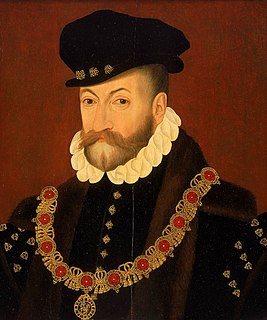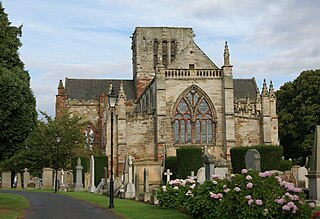
Year 1578 (MDLXXVIII) was a common year starting on Wednesday of the Julian calendar.
Edward Sutton, 4th Baron Dudley was an English nobleman and soldier. Contemporary sources also refer to him as Sir Edward Dudley.

Edward Fiennes de Clinton, 1st Earl of Lincoln, KG was an English nobleman and Lord High Admiral.
Sir Richard Lee (1513–1575) was a military engineer in the service of Henry VIII of England, Edward VI and Elizabeth I. He was a commander of Henry VIII and appointed surveyor of the King's works. Lee was member of parliament for Hertfordshire in 1545.

Admiral Sir William Wynter was an admiral and principal officer of the Council of the Marine under Queen Elizabeth I of England and served the crown during the Anglo-Spanish War (1585–1604).

The Sieges of Haddington were a series of sieges staged at the Royal Burgh of Haddington, East Lothian, Scotland, as part of the War of the Rough Wooing one of the last Anglo-Scottish Wars. Following Regent Arran's defeat at the battle of Pinkie Cleugh on Saturday 10 September 1547, he took Haddington, with 5000 troops including French mercenaries and troops sent by Henry II of France to bolster the Auld Alliance. Afterwards, Francis Talbot, 5th Earl of Shrewsbury took it with nearly 15000. The English forces built artillery fortifications and were able to withstand an assault by the besieging French and Scots troops supported by heavy cannon in July 1548. Although the siege was scaled down after this unsuccessful attempt, the English garrison abandoned the town on 19 September 1549, after attrition by Scottish raids at night, sickness, and changing political circumstance.
Mary Willoughby was a ship of the English Tudor navy. She appears in the navy lists from 1535, during the reign of Henry VIII. She was named after Maria Willoughby, a lady-in-waiting and close friend of Catherine of Aragon. The ship was taken by the Scots in 1536 and was included in the Royal Scots Navy, The English recaptured her in 1547. The ship was rebuilt in 1551, increasing in size from 140 bm to 160 bm.

Henri Cleutin, seigneur d'Oisel et de Villeparisis, was the representative of France in Scotland from 1546 to 1560, a Gentleman of the Chamber of the King of France, and a diplomat in Rome 1564-1566 during the French Wars of Religion.
Patrick Gray, 4th Lord Gray was a Scottish landowner and Sheriff of Angus, active during the war of the Rough Wooing as a supporter of the Scottish Reformation.

Sir James Wilsford was an English soldier and politician, who was commander at the Siege of Haddington in the war known as the Rough Wooing and also sat as Member of Parliament for Barnstaple.

Sir Andrew Dudley, KG was an English soldier, courtier, and diplomat. A younger brother of John Dudley, 1st Duke of Northumberland, he served in Henry VIII's navy and obtained court offices under Edward VI. In 1547–1548 he acted as admiral of the fleet and participated in the War of the Rough Wooing in Scotland, where he commanded the English garrison of Broughty Castle. He was appointed captain of the fortress of Guînes in the Pale of Calais in late 1551. There he got involved in a dispute with the Lord Deputy of Calais, which ended only when both men were replaced in October 1552.
Lion was the name of five warships of the Royal Scottish Navy during the 16th century, some of which were prizes captured by, and from the English. The names of these ships reflect the Royal Arms of Scotland and its central motif of the Lion Rampant.
Thomas Fisher or Hawkins, was an English politician.

Sir John Luttrell is an allegorical oil painting of a Tudor soldier.
Ninian Cockburn was a Scottish soldier and officer of the Garde Écossaise, a company which guarded the French king. He had an ambiguous role in political relations between Scotland, France and England during the war of the Rough Wooing and the Scottish Reformation.
Jean or Jehan Scheyfve,, Seigneur de Rode-Saint-Agathe, was the ambassador of the Holy Roman Empire to England from May 1550 to October 1553.
















